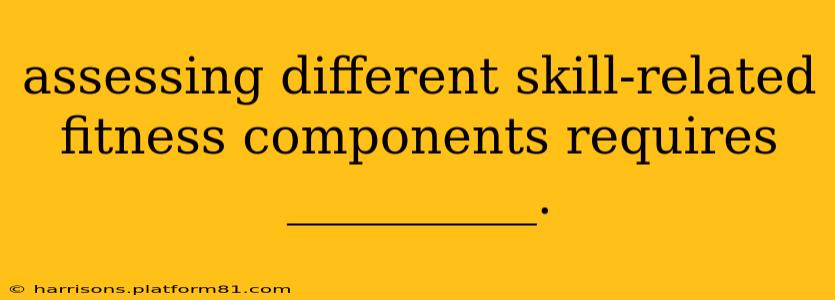Assessing Different Skill-Related Fitness Components Requires Multiple Methods and Considerations
Assessing skill-related fitness components requires a multifaceted approach that goes beyond simple measurements. Unlike health-related fitness, which focuses on elements like cardiovascular endurance and body composition, skill-related fitness hinges on abilities that are more nuanced and require specific testing protocols. This means a variety of tests, careful observation, and often subjective judgment are necessary to gain a comprehensive understanding of an individual's skill-related fitness profile.
Here's a breakdown of what's involved in assessing different skill-related fitness components:
What are Skill-Related Fitness Components?
Before diving into assessment methods, let's clarify what constitutes skill-related fitness. These components represent the abilities that contribute to successful performance in sports and other physical activities. They include:
- Agility: The ability to change direction quickly and efficiently.
- Balance: Maintaining equilibrium while stationary or moving.
- Coordination: Using different parts of the body together smoothly and efficiently.
- Power: The combination of strength and speed to exert force quickly.
- Reaction Time: The time it takes to respond to a stimulus.
- Speed: The ability to perform a movement or cover a distance quickly.
Assessing Skill-Related Fitness Components: Specific Tests and Considerations
Different components demand different assessment methods. There's no single test to cover everything. Here are some common approaches:
1. Agility Testing:
Several tests assess agility, each with slight variations:
- T-test: Measures the ability to change direction quickly. The time taken to complete a pre-defined pattern is recorded.
- Illinois Agility Test: A more complex test involving shuttles and changes in direction.
- Shuttle Run: Measures speed and agility in short bursts.
The choice of test often depends on the specific sport or activity being considered. Furthermore, proper technique and standardized instructions are crucial for accurate and reliable results.
2. Balance Testing:
Balance assessments can range from simple to complex:
- Stork Stand Test: Measures static balance by standing on one leg.
- Balance Board Tests: Assess dynamic balance through the use of specialized equipment.
- Functional Balance Tests: Evaluate balance in more real-world scenarios, often involving changes in surface or movement.
Accurate scoring relies on clear instructions and objective measures of time or stability loss.
3. Coordination Testing:
Coordination tests often involve hand-eye or body coordination:
- Hand-Eye Coordination Tests: These may involve catching a ball or following a moving object with the eyes and hands.
- Body Coordination Tests: Could include tests that require complex body movements, like juggling or sequential movements.
These tests require subjective and objective observation, noting both accuracy and fluidity of movement.
4. Power Testing:
Power is assessed by tests that combine strength and speed:
- Vertical Jump Test: Measures the height an individual can jump.
- Broad Jump Test: Measures the horizontal distance an individual can jump.
- Medicine Ball Throw: Evaluates the ability to exert force quickly.
Accurate measurement necessitates precision in measuring tools and controlling extraneous variables.
5. Reaction Time Testing:
Reaction time is typically measured using simple response devices:
- Ruler Drop Test: Measures the time it takes to catch a falling ruler.
- Computerized Reaction Time Tests: Provide more precise and controlled measurements.
Accurate measurement relies on standardized procedures and equipment.
6. Speed Testing:
Speed tests are dependent upon the distance:
- 40-Yard Dash (or 100m dash): Measures speed over short distances.
- Timed Runs: Assess speed over longer distances.
Precise timing mechanisms are essential for accurate results.
Considering Individual Factors
It's crucial to remember that individual factors such as age, gender, and training level significantly influence skill-related fitness. Assessments should be tailored to the individual's specific characteristics and goals. A qualified professional can help select the appropriate tests and interpret the results accurately.
Frequently Asked Questions (FAQs)
This section will address commonly asked questions regarding the assessment of skill-related fitness components. Note that these are often found in the “People Also Ask” section of search engine results. While specific FAQs vary based on the search terms used, the following represent common queries:
How do you measure skill-related fitness?
As detailed above, measuring skill-related fitness requires a variety of tests and methods depending on the specific skill being assessed. There is no single test or measurement that can comprehensively evaluate all skill-related fitness components. A combination of tests and observation is necessary for a complete picture.
What are the tests for skill-related fitness?
Numerous tests exist to assess different aspects of skill-related fitness. Examples include the T-test for agility, the stork stand test for balance, the ruler drop test for reaction time, and vertical jump tests for power. The best test will depend on the specific skill being evaluated and the individual's capabilities.
What are the different components of skill-related fitness?
Skill-related fitness comprises agility, balance, coordination, power, reaction time, and speed. These components represent the abilities that contribute to successful performance in sports and other physical activities.
Why is skill-related fitness important?
Skill-related fitness is essential for improved performance in sports and many physical activities. Developing these skills enhances proficiency, reduces risk of injury, and increases overall enjoyment and success in athletic endeavors.
By utilizing a comprehensive approach that considers these various factors and employing a combination of objective testing and subjective observation, a thorough assessment of skill-related fitness components is possible. This information is invaluable for athletes, coaches, and fitness professionals in tailoring training programs and maximizing performance.
